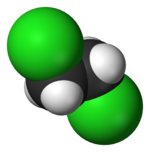1,2-Dichloroethane
| 1,2-Dichloroethane | |
|---|---|
 |
|
 |
|
| IUPAC name | 1,2-dichloroethane |
| Other names | Ethylene dichloride Ethane dichloride Dutch liquid, Dutch oil Freon 150 |
| Identifiers | |
| CAS number | 107-06-2 |
| RTECS number | KI0525000 |
| SMILES |
|
| Properties | |
| Molecular formula | C2H4Cl2 |
| Molar mass | 98.96 g/mol |
| Appearance | Colourless liquid with characteristic odour |
| Density | 1.253 g/cm³, liquid |
| Melting point |
-35 °C (238 K) |
| Boiling point |
83.5–84.0 °C (357 K) |
| Solubility in water | 0.87 g/100 ml (20 °C) |
| Viscosity | 0.84 mPa·s at 20 °C |
| Structure | |
| Dipole moment | 1.80 D |
| Hazards | |
| Main hazards | toxic, flammable, corrosive |
| NFPA 704 |
 3
2
0
|
| R-phrases | R11, R45, R36/37/38 |
| S-phrases | S45, S53 |
| Flash point | 13 °C |
| Related compounds | |
| Related haloalkanes | methyl chloride methylene chloride 1,1,1-trichloroethane |
| Related compounds | ethylene chlorine vinyl chloride polyvinyl chloride |
| Except where noted otherwise, data are given for materials in their standard state (at 25 °C, 100 kPa) Infobox references |
|
The chemical compound 1,2-dichloroethane, commonly known by its old name of ethylene dichloride (EDC), is a chlorinated hydrocarbon, mainly used to produce vinyl chloride monomer (VCM, chloroethene), the major precursor for PVC production. It is a colourless liquid with a chloroform-like odour. 1,2-Dichloroethane is also used generally as an intermediate for other organic chemical compounds, and as a solvent.
Contents |
History
In 1794, a group of four Dutch friends under the name of Gezelschap der Hollandsche Scheikundigen (Society of Dutch Chemists) consisted of physician Jan Rudolph Deiman, merchant Adriaan Paets van Troostwijk, chemist Anthoni Lauwerenburg and botanist Nicolaas Bondt. They were the first to produce 1,2-dichloroethane from olefiant gas (oil-making gas, ethylene) and chlorine gas. Although the Gezelschap in practice didn't do much in-depth scientific research, they and their publications were highly regarded. Part of that acknowledgement is that 1,2-dichloroethane has been called Dutch oil in old chemistry.
Chemistry
1,2-Dichloroethane has chemical formula C2H4Cl2.
Cf. 1,1-Dichloroethane (ethylidene dichloride).
Production
Every year 17.5 million tons of 1,2-dichloroethane are produced in the United States, Western Europe and Japan.[1] This is primarily achieved through the iron(III) chloride catalysed reaction of ethene (ethylene) and chlorine.
- H2C=CH2 + Cl2 → Cl-CH2-CH2-Cl
In subsequent reactions, notably to vinyl chloride (chloroethene), hydrogen chloride is formed and re-used in a copper(II) chloride catalysed reaction, to also produce 1,2-dichloroethane from ethene and oxygen.
- H2C=CH2 + 2 HCl + ½ O2 → Cl-CH2-CH2-Cl + H2O
Uses
Vinyl chloride monomer (VCM) production
With approximately 80% of the world's consumption of 1,2-dichloroethane, the major application is in the production of vinyl chloride monomer (VCM, chloroethene), which is the precursor to polyvinyl chloride under the formation of hydrogen chloride.
- Cl-CH2-CH2-Cl → H2C=CH-Cl + HCl
The hydrogen chloride can be re-used in the production process, in the formation of more 1,2-dichloroethane (see Production).
Other Uses
As a good apolar aprotic solvent, 1,2-dichloroethane is used as degreaser and paint remover. As a useful 'building block' reagent, it is used as an intermediate in the production of various organic compounds. It is also used as a reagent as an electrophilic source of chlorine, with elimination of ethene and chloride.
Historically, it was used as an anti-knock additive in leaded fuels.
Safety
1,2-dichloroethane is toxic (especially by inhalation due to its high vapour pressure), corrosive, highly flammable, and possibly carcinogenic. Its high solubility and 50-year half-life in anoxic aquifers make it a perennial pollutant and health risk that is very expensive to treat conventionally, requiring a method of bioremediation.[2]
Substitutes are recommended and will vary according to application. 1,3-dioxolane and toluene are possible substitutes as solvents.
References
- ↑ J.A. Field & R. Sierra-Alvarez (2004). "Biodegradability of chlorinated solvents and related chlorinated aliphatic compounds". Rev. Environ. Sci. Biotechnol. 3: 185–254. doi:.
- ↑ S. De Wildeman & W. Verstraete (25 Mar., 2003). "The quest for microbial reductive dechlorination of C2 to C4 chloroalkanes is warranted". Appl. Microbiol. Biotechnol. 61 (2): 94–102. doi:.
External links
- Gezelschap der Hollandsche Scheikundigen
- ChemicalLand compound database
- Environmental Chemistry compound database
- Merck Chemicals database
- National Pollutant Inventory - 1,2 Dichlorethane Fact Sheet
- Locating and estimating air emissions from sources of ethylene dichloride, EPA report EPA-450/4-84-007d, March 1984